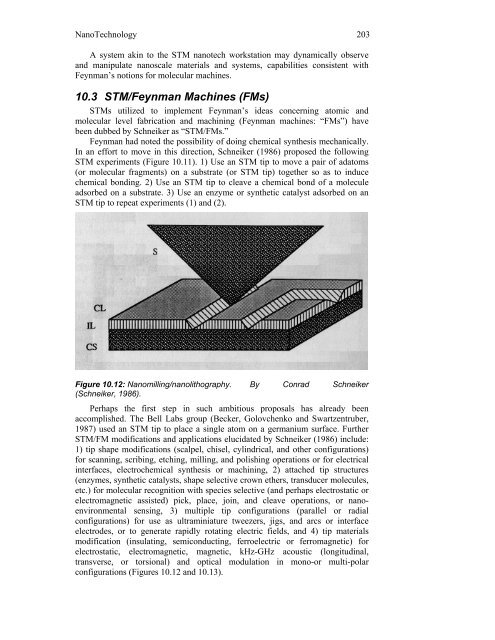ULTIMATE COMPUTING - Quantum Consciousness Studies
ULTIMATE COMPUTING - Quantum Consciousness Studies
ULTIMATE COMPUTING - Quantum Consciousness Studies
- No tags were found...
Create successful ePaper yourself
Turn your PDF publications into a flip-book with our unique Google optimized e-Paper software.
NanoTechnology 203<br />
A system akin to the STM nanotech workstation may dynamically observe<br />
and manipulate nanoscale materials and systems, capabilities consistent with<br />
Feynman’s notions for molecular machines.<br />
10.3 STM/Feynman Machines (FMs)<br />
STMs utilized to implement Feynman’s ideas concerning atomic and<br />
molecular level fabrication and machining (Feynman machines: “FMs”) have<br />
been dubbed by Schneiker as “STM/FMs.”<br />
Feynman had noted the possibility of doing chemical synthesis mechanically.<br />
In an effort to move in this direction, Schneiker (1986) proposed the following<br />
STM experiments (Figure 10.11). 1) Use an STM tip to move a pair of adatoms<br />
(or molecular fragments) on a substrate (or STM tip) together so as to induce<br />
chemical bonding. 2) Use an STM tip to cleave a chemical bond of a molecule<br />
adsorbed on a substrate. 3) Use an enzyme or synthetic catalyst adsorbed on an<br />
STM tip to repeat experiments (1) and (2).<br />
Figure 10.12: Nanomilling/nanolithography. By Conrad Schneiker<br />
(Schneiker, 1986).<br />
Perhaps the first step in such ambitious proposals has already been<br />
accomplished. The Bell Labs group (Becker, Golovchenko and Swartzentruber,<br />
1987) used an STM tip to place a single atom on a germanium surface. Further<br />
STM/FM modifications and applications elucidated by Schneiker (1986) include:<br />
1) tip shape modifications (scalpel, chisel, cylindrical, and other configurations)<br />
for scanning, scribing, etching, milling, and polishing operations or for electrical<br />
interfaces, electrochemical synthesis or machining, 2) attached tip structures<br />
(enzymes, synthetic catalysts, shape selective crown ethers, transducer molecules,<br />
etc.) for molecular recognition with species selective (and perhaps electrostatic or<br />
electromagnetic assisted) pick, place, join, and cleave operations, or nanoenvironmental<br />
sensing, 3) multiple tip configurations (parallel or radial<br />
configurations) for use as ultraminiature tweezers, jigs, and arcs or interface<br />
electrodes, or to generate rapidly rotating electric fields, and 4) tip materials<br />
modification (insulating, semiconducting, ferroelectric or ferromagnetic) for<br />
electrostatic, electromagnetic, magnetic, kHz-GHz acoustic (longitudinal,<br />
transverse, or torsional) and optical modulation in mono-or multi-polar<br />
configurations (Figures 10.12 and 10.13).






